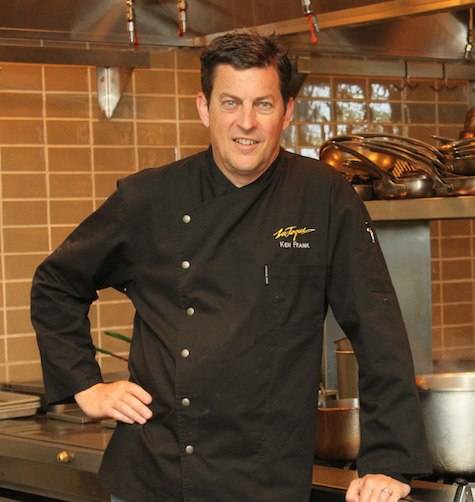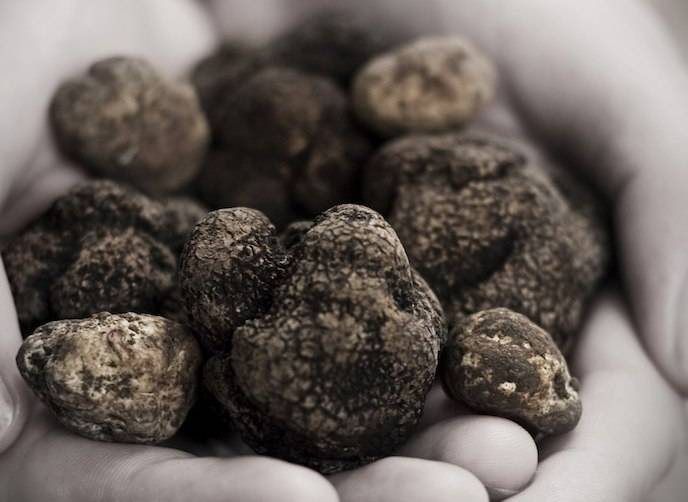10 Things You Don’t Know About Truffles

Photo Credit: Napa Truffle Festival
Truffles are everywhere these days! There’s truffle French fries, truffle ice cream, truffled macaroni and cheese, hamburgers with truffle shavings, eggs with truffles, truffles atop pasta and we can go on. Sometimes these aromatic delicacies belong—and sometimes not. For a crash course on truffles, whether you’re buying them for home use or eating them at restaurants, we let Ken Frank, executive chef of the Michelin-starred La Toque restaurant inside the Westin Verasa Napa Valley, share his knowledge—for this man knows his truffles. We caught up to Frank at La Toque, the morning after he and a few other top chefs prepared an extravagant, mind-blowing dinner during the 6th Annual Napa Truffle Festival.

Photo Credit: Napa Valley Truffle Festival1.
1. Quality
Use the best quality truffles you can possibly find—and that means the freshest, best truffles possible. You can find them online, if you’re in an urban area you can buy them in fancy stores. Whole Foods often has them. Dean & DeLuca would have them up in St. Helena. High-end markets in Rockridge or downtown San Francisco might have them. You can absolutely find them online, but get them from one of the well-established online retailers—or best, from your friendly local chef—if he will sell you some, which I have done for customers from time to time. [People] ask a week in advance, and I get them a couple ounces. I’m happy to do it. The more I buy, the better quality I get.
2. Time
Use them up quickly because they do have a short window of extreme flavor and aroma you want to capture. Their aroma deteriorates quickly over a period of a week or so. They’ll lose maybe half of that. They’ll still have flavor, but they’ll lose quite a bit of aroma.
3. Storing them
You should not only store them properly, but store them with eggs because storing them with eggs makes the eggs taste better—and it’s free. When you’re spending as much money as you are on truffles, if you get something free out of them, take it.”
4. Avoid truffle products
While they have very similar flavor and lots of it, there are two problems with it. One, it doesn’t reflect the complex set of aromas and flavors that you get with truffles. It’s very muddled and one dimensional. Two, and perhaps the worst part, is if you condition your palate to truffle oil as real truffle flavor it’s going to be a lot harder to appreciate when you have real subtle, delicious, exquisite truffles.

5. What to cook them with
Next would be, make good choices about what you cook them with and how you use them, and use them in a variety of ways. Certainly putting them into fresh cheese, putting them into butter, storing them with eggs, where you can get the flavor to infuse, is a really good thing. Don’t cook them with other strong spicy or acidic flavors because you’ll just cover up the truffle. No tomato sauce, no spicy, you don’t need jalapeños. Truffles, on the one hand, they are strong; but on the other hand they’re also subtle at the same time. It’s an aroma that is almost primal in it’s quality. But it’s not going to beat up on lemon juice and it’s not going to beat up on jalapeños. And it’s not going to beat up on somebody’s spice rub—so let the truffle shine.
6. Go big or go home
Yes truffles are stupid expensive, but they’re really wonderful. When you do choose to use them, go big or go home. Use enough so you can really appreciate the punch that they bring to something.
7. Truffle shaver
Invest in a good truffle shaver that you can adjust to really thin, because the thinner your slices, the more slices per truffle you will get. When you’re looking for perfume, when you’re shaving something on top as you would a pizza or a pasta, or a risotto, one thing to think about is maximizing the surface area because that’s how you maximize the amount of aroma that’s released. So if you cut your truffle into 10 slices that are all the size of a 50¢ piece that’s the surface area you’ve got. But if you cut it into 40 slices the size of a 50¢ piece and they’re thinner, you’ve got four times the surface area. Microplane is a really good trick too because you’re maximizing the surface area and that’s what releases these delicious, volatile flavors. Microplane is a grater with little tiny razor sharp points. It’s a very high-tech tool available in great kitchen shops and it’s also really excellent for grating parmesan cheese. Parmesan cheese and truffles are very, very friendly. Pasta, butter, parmesan, truffles, salt—that may be all you need. You don’t have to overcomplicate cooking with truffles.
8. Cooking time & temperature
Do not cook truffles too hot or for too long because many of the volatile flavor compounds boil off at very low temperatures and if you cook them too long or too hot you’re simply evaporating a lot of the flavor before you get a chance to eat it. If you’re putting them into a sauce, you put them in for a few minutes at the end. Simmering for hours to make truffle stock makes dirty water—very expensive dirty water.
9. The cost
The price of fresh truffles is set about once a week. It’s a very interesting world market. It’s a cash market. It goes up or down based on supply and demand that is largely based on two factors—one is holidays and two is weather. If it’s too wet or too cold, dogs can’t go hunt truffles and truffle hunters aren’t going to slog through the mud to get them, or if it’s too cold and the ground is frozen over the dog is not going to smell the truffle through ice. The dog is not going to dig through ice; the dog wants to stay home. You can’t find them without a dog or a pig; we just don’t have the ability to run around on four legs with our nose on the ground and smell truffles. The last few years the normal wholesale price for good quality white truffles has hovered right around $2,000 a pound. Consumers can expect to pay a bit more than that for small quantities. The wholesale price for top quality black truffles, both in the summer and the winter, whether they’re from Australia or from Europe, has hovered right around $750 a pound. Again, consumers should expect to pay a bit more when they’re buying small quantities. At the very beginning of the season it goes up because it’s really scarce—and they’re often not the best anyway—and around the holidays, at Christmas and New Year’s, it absolutely goes up. I would encourage people also to experiment in the northern hemisphere, to take advantage of that you now get fresh truffles in the summer because it’s Australia’s winter and the opportunity to combine butter, corn and fresh black truffles is one that should not be missed. Corn and butter is good; pretty much anything that’s good with butter is going to be good with truffle added to it.
10. Save the scraps
As a special treat, if you save every scrap of truffle you have, chop it up and mix it into soft butter and freeze it to surprise yourself at a later date. If you put it into butter, the butter will absorb a pretty impressive amount of flavor. It’s not the same as a fresh truffle because it doesn’t preserve perfume. But perfume is available only fresh. With cans and frozen, you have flavor and you have aroma, but you don’t have that crazy perfume that travels 20 feet.












